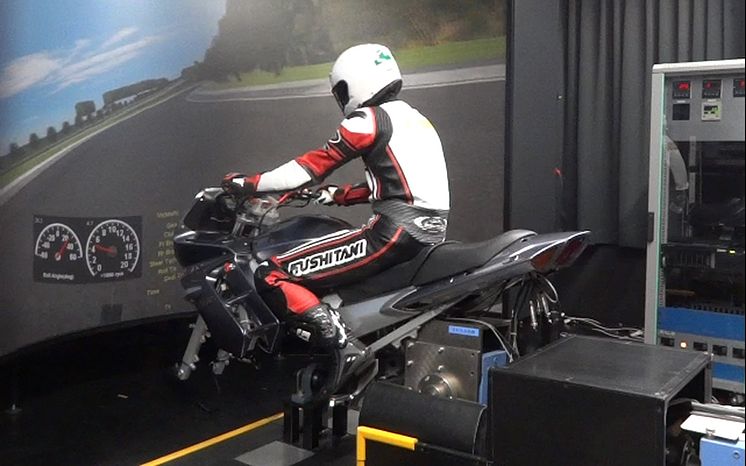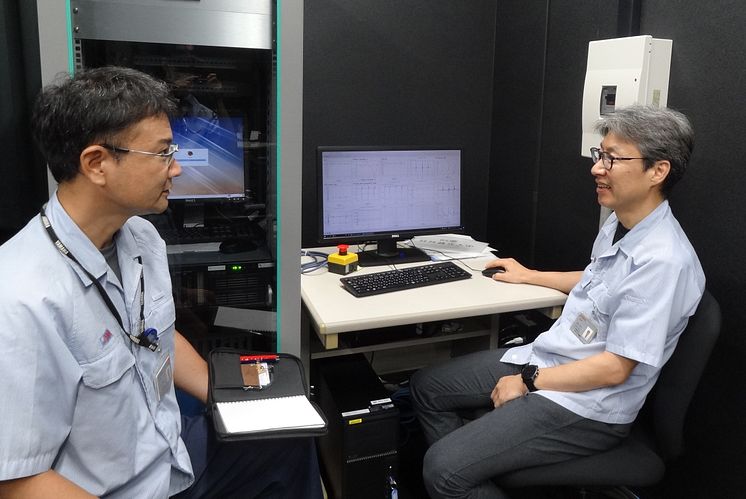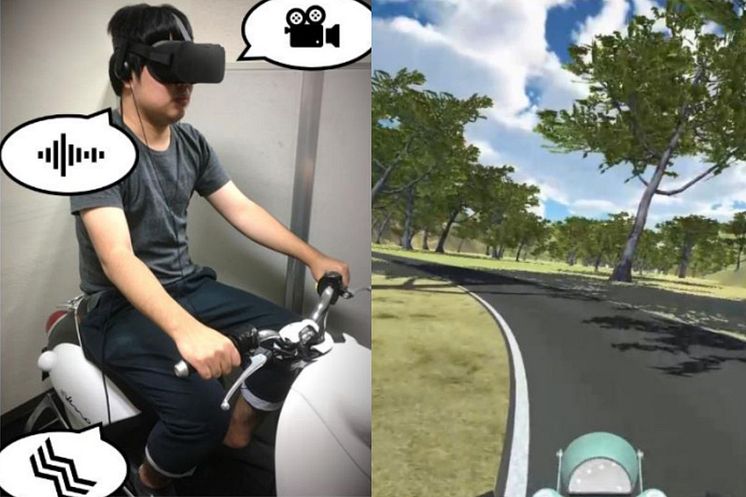
News -
Motorcycle R&D That Sparked a Study of VR-Induced Motion Sickness Yamaha Motor Newsletter (Jan. 18, 2021 No. 83)
Thanks to advances in virtual reality technology, today we are seeing its use spread to various fields, from day-to-day life to commerce and industry. However, this greater use of virtual reality (VR) equipment and headsets has also resulted in many reports of people suffering afterwards from symptoms similar to car-induced motion sickness. This has put the brakes on expanding the range of usage and applicability to some degree.
Yamaha Motor was, in fact, confronting the same issue in its motorcycle R&D, and launched a joint research project with researchers at Shizuoka University, later releasing a paper outlining a possible approach for solving this issue.
New Applications and Challenges with VR Technology

Participating in the joint research project were Masayuki Miki (left) and Tetsuya Kimura (right), both employees in the Technical Research & Development Center’s Fundamental Technology Research Division.
From use in entertainment like amusement park rides, home movies and video games to practical uses like training at driving schools and virtual tours of tentative designs by housing construction companies, use of virtual reality (VR) technology is rapidly spreading into a variety of fields. However, there have also been numerous reports of VR use causing people to experience a dizziness similar to car-induced motion sickness, in what is now referred to simply as “VR sickness.” This has emerged as one standout issue to be tackled as the development and spread of VR technology continues.
It was in May 2020 that a research paper concerning VR sickness was published in the
Scientific Reports journal of Nature Research. Authored by a joint research group from Shizuoka University (headed by assistant professor Yoshihiro Itaguchi of the Makoto Miyazaki Lab) and Yamaha Motor, the report states that “simultaneous presentation of engine sounds and vibration, which were synchronous to each other and tightly coupled with the visual flow speed, effectively reduces [visually induced motion sickness] while experiencing motorcycling simulators.” With the growing interest in VR sickness in the academic world today, this report attracted widespread attention among researchers and technicians around the world.
The experiment itself had 80 test participants do indoor simulated rides on a scooter while wearing a VR headset, and after this their degree of VR sickness was evaluated across a 20-level scale. The results indicated that it was only when the video of surrounding scenery was matched by accompanying sounds and vibrations to simulate an actual scooter ride that a significant reduction in VR sickness was seen.
Riding Real Roads in Virtual Worlds

The 80 test participants were evaluated for VR sickness over the 20-level Fast Motion Sickness scale.
“In our research of motorcycle handling stability, Yamaha has been using riding simulators built around actual motorcycles for some time,” says Masayuki Miki, a member of the joint research team and employee in the Fundamental Technology Research Division at Yamaha’s Technical Research & Development Center. “Since VR allows us to ‘ride’ a wide range of products on all kinds of road environments we’ve created, our simulators and VR equipment play an important role in our research into rider–machine dynamics. It also goes toward achieving our
Jin-Ki Kanno development ideal as well as serving as a component contributing to the strong reputation we have for Yamaha Handling.”
However, for all its benefits, this still had its own issue—VR sickness. Since there were more than a few test riders that would experience VR sickness during research work, Yamaha wanted to do something to address the problem. The Makoto Miyazaki Lab at Shizuoka University had already recognized the potential for further research in this field, and a meeting with Yamaha eventually led to the start of the joint research project.
“At Yamaha, we already had our own theories based on experience, like that no accompanying sound in the simulations seemed to make the sickness worse or that vibration seemed to help reduce its degree, but we had no clear evidence for any of them,” says Miki. “If this ongoing research project leads to a substantive solution, it will become possible to have riders with different riding techniques and perceptions participate in virtual test-rides of prototype vehicles in the early stages of development using existing roads from around the world. I’m sure that this will lead to product development that is not just more efficient and more in line with the actual use conditions of our customers, but also result in products with greater performance, functionality and more uniquely Yamaha qualities. It will surely also help with creating social VR environments and facilitating remote communication.”
Research Paper

https://www.nature.com/articles/s41598-020-64302-y
Published in: Scientific Reports
Title: Effects of synchronised engine sound and vibration presentation on visually induced motion sickness
Authors: Yuki Sawada, Yoshihiro Itaguchi, Masami Hayashi, Kosuke Aigo, Takuya Miyagi, Masayuki Miki, Tetsuya Kimura, Makoto Miyazaki
|
Message from the Editor Yamaha Motor has endeavored to reveal the workings of the rider–machine relationship in a longstanding tradition in line with our development ideal of Jin-Ki Kanno, and advances in VR technology may become one important step towards unlocking previously unknown secrets. But for me, it was a surprising revelation to find out that even our motorcycle test riders, who are quite naturally experts at what they do, aren’t immune to VR sickness from simulators! Maiko Kawai |


